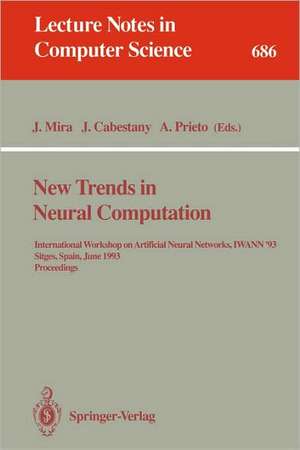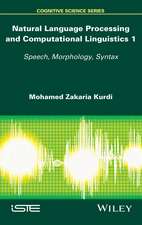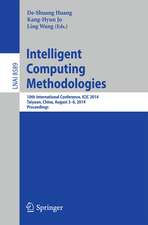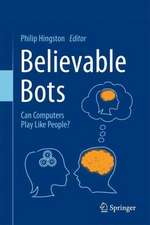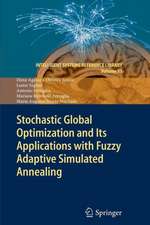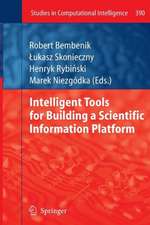New Trends in Neural Computation: International Workshop on Artificial Neural Networks, IWANN'93, Sitges, Spain, June 9-11, 1993. Proceedings: Lecture Notes in Computer Science, cartea 686
Editat de Jose Mira, Joan Cabestany, Alberto Prietoen Limba Engleză Paperback – 27 mai 1993
Din seria Lecture Notes in Computer Science
- 20%
 Preț: 1061.55 lei
Preț: 1061.55 lei - 20%
 Preț: 307.71 lei
Preț: 307.71 lei - 20%
 Preț: 438.69 lei
Preț: 438.69 lei - 20%
 Preț: 645.28 lei
Preț: 645.28 lei -
 Preț: 410.88 lei
Preț: 410.88 lei - 15%
 Preț: 580.46 lei
Preț: 580.46 lei - 17%
 Preț: 427.22 lei
Preț: 427.22 lei - 20%
 Preț: 596.46 lei
Preț: 596.46 lei -
 Preț: 381.21 lei
Preț: 381.21 lei - 20%
 Preț: 353.50 lei
Preț: 353.50 lei - 20%
 Preț: 1414.79 lei
Preț: 1414.79 lei - 20%
 Preț: 309.90 lei
Preț: 309.90 lei - 20%
 Preț: 583.40 lei
Preț: 583.40 lei - 20%
 Preț: 1075.26 lei
Preț: 1075.26 lei - 20%
 Preț: 310.26 lei
Preț: 310.26 lei - 20%
 Preț: 655.02 lei
Preț: 655.02 lei - 20%
 Preț: 580.93 lei
Preț: 580.93 lei - 20%
 Preț: 340.32 lei
Preț: 340.32 lei - 15%
 Preț: 438.59 lei
Preț: 438.59 lei - 20%
 Preț: 591.51 lei
Preț: 591.51 lei - 20%
 Preț: 649.49 lei
Preț: 649.49 lei - 20%
 Preț: 337.00 lei
Preț: 337.00 lei -
 Preț: 449.57 lei
Preț: 449.57 lei - 20%
 Preț: 607.39 lei
Preț: 607.39 lei - 20%
 Preț: 1024.44 lei
Preț: 1024.44 lei - 20%
 Preț: 579.30 lei
Preț: 579.30 lei - 20%
 Preț: 763.23 lei
Preț: 763.23 lei - 20%
 Preț: 453.32 lei
Preț: 453.32 lei - 20%
 Preț: 575.48 lei
Preț: 575.48 lei - 20%
 Preț: 585.88 lei
Preț: 585.88 lei - 20%
 Preț: 825.93 lei
Preț: 825.93 lei - 20%
 Preț: 763.23 lei
Preț: 763.23 lei - 17%
 Preț: 360.19 lei
Preț: 360.19 lei - 20%
 Preț: 1183.14 lei
Preț: 1183.14 lei - 20%
 Preț: 340.32 lei
Preț: 340.32 lei - 20%
 Preț: 504.57 lei
Preț: 504.57 lei - 20%
 Preț: 369.12 lei
Preț: 369.12 lei - 20%
 Preț: 583.40 lei
Preț: 583.40 lei - 20%
 Preț: 343.62 lei
Preț: 343.62 lei - 20%
 Preț: 350.21 lei
Preț: 350.21 lei - 20%
 Preț: 764.89 lei
Preț: 764.89 lei - 20%
 Preț: 583.40 lei
Preț: 583.40 lei -
 Preț: 389.48 lei
Preț: 389.48 lei - 20%
 Preț: 341.95 lei
Preț: 341.95 lei - 20%
 Preț: 238.01 lei
Preț: 238.01 lei - 20%
 Preț: 538.29 lei
Preț: 538.29 lei
Preț: 668.87 lei
Preț vechi: 836.09 lei
-20% Nou
Puncte Express: 1003
Preț estimativ în valută:
128.01€ • 132.24$ • 106.53£
128.01€ • 132.24$ • 106.53£
Carte tipărită la comandă
Livrare economică 26 martie-09 aprilie
Preluare comenzi: 021 569.72.76
Specificații
ISBN-13: 9783540567981
ISBN-10: 3540567984
Pagini: 772
Ilustrații: XVIII, 754 p.
Dimensiuni: 155 x 235 x 41 mm
Greutate: 1.06 kg
Ediția:1993
Editura: Springer Berlin, Heidelberg
Colecția Springer
Seria Lecture Notes in Computer Science
Locul publicării:Berlin, Heidelberg, Germany
ISBN-10: 3540567984
Pagini: 772
Ilustrații: XVIII, 754 p.
Dimensiuni: 155 x 235 x 41 mm
Greutate: 1.06 kg
Ediția:1993
Editura: Springer Berlin, Heidelberg
Colecția Springer
Seria Lecture Notes in Computer Science
Locul publicării:Berlin, Heidelberg, Germany
Public țintă
ResearchCuprins
Biophysics of neural computation.- Integrated learning in rana computatrix.- A model for centering visual stimuli through adaptive value learning.- A model for the development of neurons selective to visual stimulus size.- An invariant representation mechanism after presynaptic inhibition.- The pancreatic B-cell as a voltage-controlled oscillator.- Approximation of the solution of the dendritic cable equation by a small series of coupled differential equations.- A neural network model inspired in global appreciations about the thalamic reticular nucleus and cerebral cortex connectivity.- Towards more realistic self contained models of neurons: High-order, recurrence and local learning.- McCulloch's neurons revisited.- Biologically motivated approach to face recognition.- Learning by reinforcement: A psychobiological model.- A neural state machine for iconic language representation.- Variable binding using serial order in recurrent neural networks.- Region of influence (ROI) networks. Model and implementation.- A node splitting algorithm that reduces the number of connections in a Hamming distance classifying network.- A high order neural model.- Higher-order networks for the optimization of block designs.- Neural Bayesian classifier.- Constructive methods for a new classifier based on a radial-basis-function neural network accelerated by a tree.- Practical realization of a radial basis function network for handwritten digit recognition.- Design of fully and partially connected random neural networks for pattern completion.- Representation and recognition of regular grammars by means of second-order recurrent neural networks.- Connectionist models for syllabic recognition in the time domain.- Sparsely interconnected artificial neural networks for associative memories.- Dynamic analysis of networks of neural oscillators.- Optimised attractor neural networks with external inputs.- Non-orthogonal bases and metric tensors: An application to artificial neural networks.- Genetic synthesis of discrete-time recurrent neural network.- Optimization of a competitive learning neural network by genetic algorithms.- Adaptive models in neural networks.- Self-organizing grammar induction using a neural network model.- The role of forgetting in efficient learning strategies for self-organising discriminator-based systems.- Simulation of stochastic regular grammars through simple recurrent networks.- Local stochastic competition and vector quantization.- MHC — An evolutive connectionist model for hybrid training.- Fast-convergence learning algorithms for multi-level and binary neurons and solution of some image processing problems.- Invariant object recognition using fahlman and Lebiere's learning algorithm.- Realization of subjective correspondence in artificial neural network trained by Fahlman and Lebiere's learning algorithm.- Bimodal distribution removal.- A simplified ARTMAP architecture for real-time learning.- B-Learning: A reinforcement learning algorithm, comparison with dynamic programming.- Increased complexity training.- Optimized learning for improving the evolution of piecewise linear separation incremental algorithms.- A method of pruning layered feed-forward neural networks.- Tests of different regularization terms in small networks.- On the distribution of feature space in Self-Organising mapping and convergence accelerating by a Kalman algorithm.- A learning algorithm to obtain self-organizing maps using fixed neighbourhood Kohonen networks.- Analysing a contingency table with Kohonen maps: A factorial correspondence analysis.-Dynamics of self-organized feature mapping.- Comparative study of self-organizing neural networks.- GANNet: A genetic algorithm for optimizing topology and weights in neural network design.- Vector quantization and projection neural network.- Constructive design of LVQ and DSM classifiers.- Linear vector classification: An improvement on LVQ algorithms to create classes of patterns.- Non-greedy adaptive vector quantizers.- Hybrid programming environments.- Automatic generation of C++ code for neural network simulation.- Urano: An object-oriented artificial neural network simulation tool.- Realistic simulation tool for early visual processing including space, time and colour data.- Language supported storage and reuse of persistent neural network objects.- Flexible operating environment for matrix based neurocomputers.- A parallel implementation of kohonen's self-organizing maps on the smart neurocomputer.- Simulation of neural networks in a distributed computing environment using Neurograph.- Full automatic ann design: A genetic approach.- Hardware implementations of artificial neural networks.- A neural network chip using CPWM modulation.- Hardware implementation of a neural network for high energy physics application.- MapA: An array processor architecture for neural networks.- Limitation of connectionism in MLP.- High level synthesis of neural network chips.- Neural network simulations on massively parallel computers: Applications in chemical physics.- A model based approach to the performance analysis of multi-layer networks realised in linear systolic arrays.- The temporal noisy-leaky integrator neuron with additional inhibitory inputs.- Architectures for self-learning neural network modules.- The generic neuron architectural framework for the automatic generationof ASICs.- A risc architecture to support neural net simulation.- Hardware design for self organizing feature maps with binary input vectors.- The Kolmogorov signal processor.- Projectivity invariant pattern recognition with high-order neural networks.- Rejection of incorrect answers from a neural net classifier.- Nonlinear time series modeling by competitive segmentation of state space.- Identification and prediction of non-linear models with recurrent neural network.- Use of unsupervised neural networks for classification of blood pressure time series.- Application of artificial neural networks to chest image classification.- Combination of self-organizing maps and multilayer perceptrons for speaker independent isolated word recognition.- An industrial application of neural networks to natural textures classification.- Use of a layered neural nets as a display method for n-dimensional distributions.- MLP modular versus yprel classifiers.- How many hidden neurons are needed to recognize a symmetrical pattern ?.- Hopfield neural network for routing.- Neural network routing controller for communication parallel multistage interconnection networks.- Adaptive routing using cellular automata.- Optimal blind equalization of Gaussian channels.- Noise prediction in urban traffic by a neural approach.- A connectionist approach to the correspondence problem in computer vision.- Self-organizing feature maps for image segmentation.- Recognition of fractal images using a neural network.- Feed forward network for vehicle license character recognition.- Interpretation of optical flow through complex neural network.- CT image segmentation by self-organizing learning.- Texture image segmentation using a modified Hopfield network.- Image compression with self-organizing networks.- Neural networks as direct adaptive controllers.- A neural adaptive controller for a turbofan exhaust nozzle.- Feed-forward neural networks for bioreactor control.- Learning networks for process identification and associative action.- On-line performance enhancement of a behavioral neural network controller.- An architecture for implementing control and signal processing neural networks.- Planlite: Adaptive planning using weightless systems.- Stock prices and volume in an artificial adaptive stock market.- Application of the Fuzzy ARTMAP neural network architecture to bank failure predictions.- Combination of neural network and statistical methods for sensory evalution of biological products: On-line beauty selection of flowers.- An adaptive information retrieval system based on Neural Networks.- Software pattern EEG recognition after a wavelet transform by a neural network.
